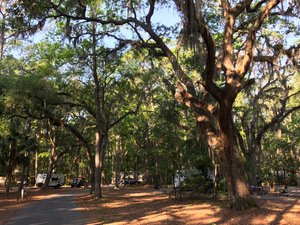Advertisement
Published: April 23rd 2017

 IMG_0546
IMG_0546
CampgroundSkidaway Island State Park, Savannah, Georgia
We hitched up and drove 115 miles up the coast to another Georgia State Park, also located on a coastal island. This is the third Georgia State Park we've stayed in and all of them have been great finds - well managed, clean, and stunningly gorgeous. And you can't beat the price, especially after the old folks discount. We always prefer state parks over commercial places and Georgia exhibits some of the best (Florida wasn't bad either!).
Drive up was relatively short and uneventful. I tried to find an alternative to Interstate 95, but there really wasn't any - out here on the coast, with all the islands, a local route can become brutally long. So we got on the interstate, put the accelerator down and drove 90 miles up the coast. Joan and I are both getting a little bored with all the green stuff - can you imagine. Seems that, except for the blue sky (when you can see it) and the black highway, everything here is just various shades of green. I suspect we are getting a little homesick for our brown and grey New Mexico with fabulous red and

 IMG_0538
IMG_0538
Our Campsite (designed for a big old motorhome)orange sunsets. (Once we are back home, we will remember the greenery back east - we are never satisfied, are we?). We will enter a new eco-region in another week or so, but for now we are stuck in the South Eastern Coastal Plain with all of its Live Oaks, Spanish Moss, and Palmettos everywhere!
Yesterday was Earth Day and, as best I can tell from Facebook posts, there was a very successful march on Washington all to support science. I don't think there has been a need for such a thing since the Inquisition times, but at least you can't say our times are boring! No doubt we will now have to go through the crowd size comparison period again - like two juveniles in the locker room.
My acknowledgement of Earth Day was to finish my book on the ecology of the Everglades (The Everglades Handbook by Thomas E. Lodge). Maybe there is a better one out there, but this one is highly recommended by all the park rangers. It catalogs the flora and fauna, of course, but it also describes in detail the different ecological zones and how they all relate to each other and

 IMG_0539
IMG_0539
Other side of our Campsitefunction as a system. I think, maybe, if I had a life do-over option, I might want to study ecology - it ties everything together in ways that individual disciplines don't.
Anyway, the last chapter is about "Man and the Everglades". It starts with an overview of the Native American presence, for which there is evidence dating more than 12,000 years old. But then he rather abruptly turns to more recent times, illustrating how little we understand about how water works in our fragile, water-dependent, world. Apparently in 1947 two hurricanes created flooding in the area which got everyone all worked up about controlling water flows. The following year, Congress created the Central and Southern Florida Project for Flood Control and Other Purposes project which began the process of digging canals and building levees to channel and direct waterflows in southern Florida. A major component of that was a 100 mile levee that separated the Everglades swamp area from developing areas east (e.g. Miami) in 1954.
Then things got interesting with the blockade of Cuba in the early 1960s. The ban on imports of sugar created a strong interest in filling the void domestically. That increased the political

 IMG_0541
IMG_0541
Joan Doing Morning Yogapower of companies like U.S. Sugar who lobbied for increased agricultural area in southern Florida to grow sugar cane. Politics, much like today, bent to the will of the power elite, and over the next couple of decades substantial segments of Everglades land were drained and converted to agricultural use. (Joan is reading another book that says that the entire effort really flooded the bank accounts of just 24 individuals.)
In the end about 50% of the massive Everglades water system was diverted to either agricultural or flood control efforts. The impact on the Everglades system was huge. The destruction of habitat and the change in water flows has had a significant effect on populations of all kinds of plants and animals with many new entries on the Endangered Species List. Certainly the creation and active efforts on the part of the National Park System entities in southern Florida have had a positive effect, but we are nowhere near restoring the Everglades ecosystem to what it once was.
I think it is important to understand the Everglades for what it is supposed to be. This is not a park established to protect a stunning natural object, like Yosemite

 IMG_0544
IMG_0544
Beautiful Park, Isn't It?Valley. In fact, I know some folks that think the Everglades, with no elevation changes and ugly, scary animals (like snakes and alligators) is just not a happy place and don't want to see it. But the Everglades is a park to celebrate, and try to protect, biodiversity. Unfortunately, that is a concept we don't appreciate well enough. But, at its core, it says that we should try to maintain as much of a living system as we can; that even the tiniest of animals or plants has a role to play, and that the destruction of a population might well have effects that we will never understand.
So on this Earth day, let us acknowledge how little we know of the natural world and support the notion that we will most likely regret destroying something that nature built over centuries of time. (17.1.46)
Advertisement
Tot: 0.192s; Tpl: 0.011s; cc: 8; qc: 41; dbt: 0.0998s; 1; m:domysql w:travelblog (10.17.0.13); sld: 1;
; mem: 1.1mb







